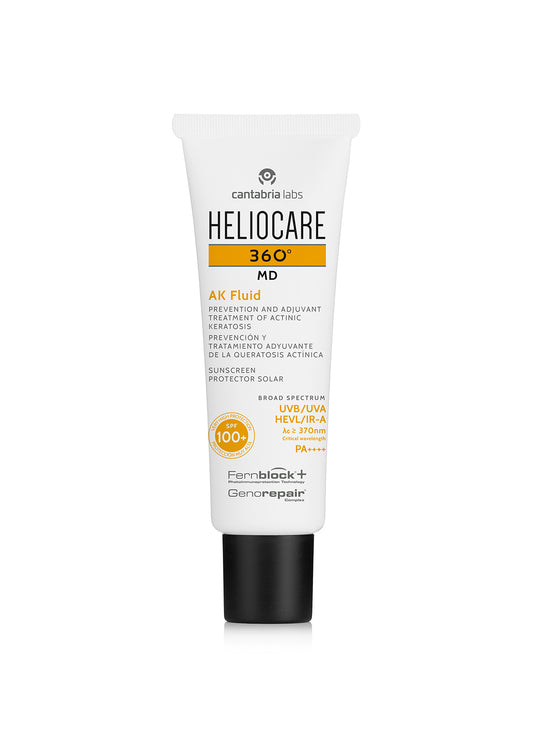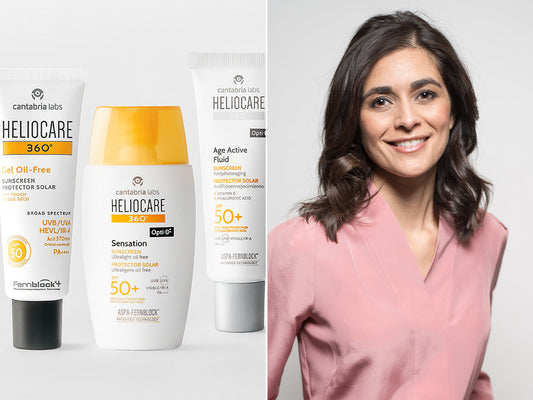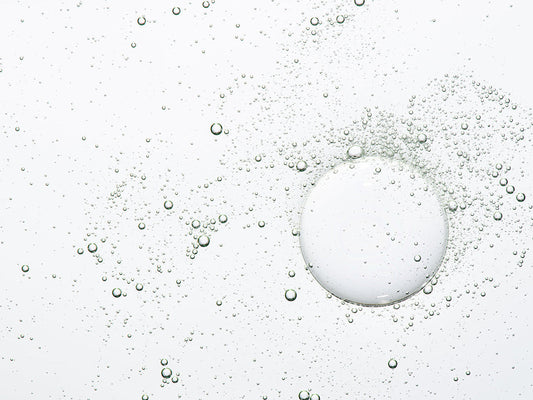DNA repair enzymes: what are they, and how do they help the skin?
Published on 21 June 2023
HELIOCARE 360° is our most advanced range of sun protection products. It provides skin with the very best daily defence against the sun and daylight, with high-level, broad-spectrum protection, and additional skin-loving ingredients that help boost skin health and prevent premature skin ageing – including the supercharged antioxidant Fernblock and DNA repair enzymes.
DNA repair enzymes are powerful proteins which are highly skilled in accelerating chemical reactions, therefore boosting the skin’s natural processes. Within skincare and sun protection, DNA repair enzymes are a vital component in improving skin health and reducing the risks of DNA damage.
But how do DNA repair enzymes work? Let’s take a closer look at skin cell DNA, how it is damaged, and how it can be repaired.
What is DNA?
Deoxyribonucleic acid (DNA) is a long, double-stranded molecule that looks like a twisted ladder. It is considered the ‘molecule of life’ because the world as we know it simply couldn’t exist without it.
DNA contains a unique genetic code that tells our bodies how to function, almost like a blueprint or recipe book. It is present within every cell in the body, guiding vital cellular functions so that we can develop, survive, and reproduce.1 The unique shape of DNA allows it to pass on important instructions with extreme precision.
DNA has a very specific structure that can be changed by chemical reactions. These changes are of great consequence compared to alterations to other cells because DNA is a permanent copy of the cell genome2 - all of the information that makes you, you.
For the most part, our DNA is able to repair any changes that are encountered. However, sometimes changes are too severe and frequent, causing irreparable mutations, cell death and deterioration. This is what leads to the development of cancer.
UV radiation and DNA damage
Ultraviolet radiation is part of the sun’s natural energy. UVA rays make up 95% of the sun’s rays, and are present all year round. They have long wavelengths that can penetrate deep into the skin, meaning sun damage isn’t immediately visible. However, UVA rays are responsible for signs of premature skin ageing, as well as DNA damage.
UVB rays, which contribute to 5% of the sun’s rays, are most harmful in the summer months. They are also stronger in locations close to the equator, of high altitude, and where there is low ozone layer coverage. UVB rays have short wavelengths that target the surface of the skin, causing sunburn and discolouration. They are also the main UV source responsible for damage to the skin cell’s DNA.
The sun also produces visible light and infrared-A, which are present all year round, no matter the weather. Both visible light and infrared-A have also been linked to DNA damage.
As such, UV radiation is the proven cause of basal cell carcinoma and squamous cell carcinoma, as well as being a contributor to the most dangerous type of skin cancer, melanoma.3
What does DNA damage look like?
While there are several immediate signs of sun damage, such as hot red skin and blisters, we won’t notice serious sun-induced DNA damage until it’s too late. What we can observe is our body trying to protect the skin from UV rays. It does this by sending alarm signals to our melanocytes, the cells that produce melanin, telling them to produce more pigment. This pigment causes a tan to develop, helping to protect the skin from further damage.3
Of course, a tan cannot prevent deep DNA damage in periods of excessive or frequent exposure. Our skin cells simply can’t keep up with the genetic changes, and the skin becomes permanently damaged, leading to mutations and cancerous growths.4 This might appear on the skin as a new lump, a changed mole, or a blemish that refuses to heal.
The more we expose our skin to the sun, the higher our risk of DNA damage. Remember, just because you haven’t burnt, doesn’t mean your DNA hasn’t been damaged. Some skin types never burn in the sun, but that doesn’t mean that skin cell DNA hasn’t been altered.
How DNA repair enzymes can help
By introducing skincare which contain DNA repair enzymes into your daily regime, you can help to prevent and repair any existing damage to your skin cell’s DNA which may have occurred because of intense or long-term exposure to the sun.
All sunscreens within the HELIOCARE 360° range contain powerful DNA repair enzymes that help repair existing DNA damage and prevent the build-up of additional damage.
The DNA repair enzymes within HELIOCARE, Roxisomes, repair both the nucleus and mitochondria of DNA, reducing mitochondrial damage by 30%. Studies have found that skin cells treated with Roxisomes show no DNA damage compared to untreated cells.
HELIOCARE 360° AK Fluid takes DNA repair a step further. Specifically formulated for skin with actinic keratosis and other forms of non-melanoma skin cancer, the AK fluid is SPF100+, PA++++, and contains the incredible GenoRepair® Complex. This is an innovative trio of DNA repair enzymes (photolyase, glycosylase, and endonuclease) which activates the three mechanisms of DNA repair to help prevent and repair damage to the skin cell’s DNA and strengthen the skin’s natural repair mechanisms.
Not only do HELIOCARE 360° sunscreens contain DNA repair enzymes, they also contain Fernblock® - the supercharged, fern-derived antioxidant that’s exclusive to HELIOCARE. Fernblock has proven protective mechanisms against the sun and daylight and has been clinically proven to help prevent and repair skin cell DNA4 along with a whole host of other skin benefits.
Find out more about HELIOCARE 360° and how it can benefit your skin health this summer, and beyond.




